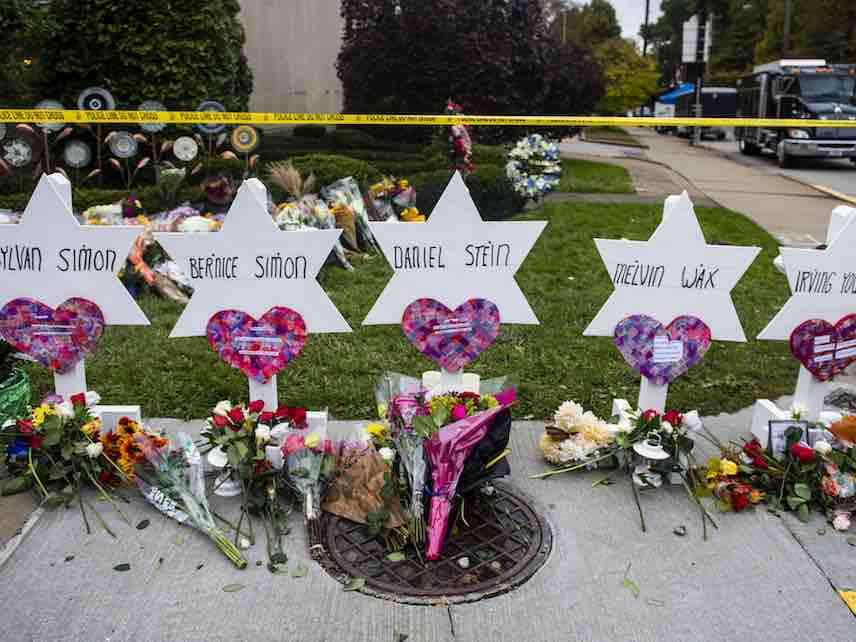The Media Keeps Saying Anti-Semitism Spiked 57% Under Trump, but That Statistic Is Really Misleading
The Anti-Defamation League's report actually showed that attacks decreased in 2017 from 2016.

In the wake of the horrific mass shooting at Tree of Life synagogue in Pittsburgh last week, many in the media claimed the attack happened amidst a climate of rising anti-Semitism: a 57 percent spike in anti-Semitic hate in 2017, fueled by the ascendance of Donald Trump to the presidency.
While it's true the anti-Semitic alt-right had a period of increased activity last year—and that Trump's divisive rhetoric about minorities, the media, and globalism certainly doesn't help matters—the evidence for the oft-cited spike is weak.
The figure comes from a report by the Jewish Anti-Defamation League. It was released back in February, but is making the rounds once again following the terrible violence in Pittsburgh. A representative piece in The Washington Post, written by GQ's Julia Ioffe, argued that "According to the Anti-Defamation League, the incidence of anti-Semitic hate crimes jumped nearly 60 percent in 2017, the biggest increase since it started keeping track in 1979. What made 2017 so different? It was Trump's first year in office."
Ioffe went on CNN and said that Trump "has radicalized so many more people than ISIS ever did," a comment that drew widespread condemnation. She subsequently apologized for using "hyperbole," but she held her ground on the underlying point. "I will add, though, that it is not a coincidence that the number of anti-Semitic attacks has jumped nearly 60% in 2017," she wrote on Twitter.
But Ioffe mischaracterized the statistic. The New York Times did as well; a March 2018 piece about the ADL's report leads with the sentence, "Anti-Semitic hate crimes are on the rise, up 57 percent in 2017 from 2016."
The ADL statistic captures anti-Semitic "incidents," which is a much broader category of behavior than "hate crimes" or "attacks." Incidents include things like bullying in schools—which is bad, but usually not indicative of criminal conduct.
Indeed, classroom and campus incidents were partly responsible for the spike, according to the ADL: "The sharp rise, reported in ADL's Audit of Anti-Semitic Incidents, was in part due to a significant increase in incidents in schools and on college campuses, which nearly doubled for the second year in a row."
But, as Volokh Conspiracy blogger and George Mason University Law Professor David Bernstein pointed out, there's actually a lot of left-wing anti-Israel sentiment on many university campuses. I don't think all criticisms of the state of Israel are inherently anti-Semitic, but it's quite possible a large number of the documented incidents in this category were perceived that way by pro-Israel students—and the originators would have been leftist activists, not Trump lovers.
The ADL report came up with three subcategories of anti-Semitic incidents: vandalism, harassment, and assault. An increase in vandalism accounts for much of the overall increase, but Bernstein doubts that all of the included incidents were actually examples of anti-Semitism. The harassment category also saw an increase, largely due to a series of bomb threats against Jewish institutions in the U.S. made by a disturbed Israeli teen. It's not at all clear that these threats were motivated by anti-Semitism.
Finally, the assault category saw a 47 percent decrease.
Compiling reliable data on hate crimes and bias incidents is tricky business, as I have noted previously. A big issue is that better reporting—more people submitting more reliable information—often masquerades as an increase in the thing being counted. It could be that in the first year of the Trump administration, watchdog groups are simply better attuned to the anti-Semitism that already existed in America.
This does not mean Trump is off the hook: His enemy-of-the-people rhetoric about the media, immigrants, societal elites, globalism, etc., is wildly irresponsible, and conservative media should stop engaging in anti-Semitic dog whistling. But we ought not to make sweeping claims about a Trump-fueled rise in anti-Semitism since the data are not all that convincing.



Show Comments (61)